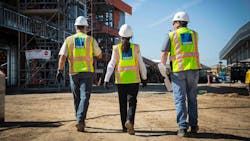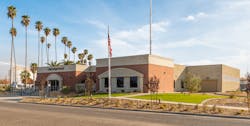Why Choose a Construction Manager for Your Next Police Facility Remodel or Build?
By Retired Corcoran Chief of Police Reuben Shortnacy, Vanir Central California Deputy Area Manager Scott Murphy and Vanir Marketing Communications Specialist Chelsea Verissimo
Construction projects can be inherently risky. The varying scopes, timelines, budgets, regulations and objectives can bring risks and challenges that project owners may not have the expertise, bandwidth or resources to manage. A public safety or emergency operations project, such as a police station remodel or new build, can be especially complex, requiring expert-level management and oversight. This is where an experienced program, project and construction management firm like Vanir can help.What is a CM?
The role of a CM refers to the individual or firm tasked with representing the interest of the owner throughout the lifecycle of a project or program. As the project’s eyes and ears, the CM is the primary point of contact between the owner and project team, including the contractor, subcontractors, architect, engineer, consultants and stakeholders. The CM brings hands-on experience to the task of completing projects in the most productive and cost-efficient manner possible. Depending on the scope of services the owner requests, a CM’s role can vary from project to project. From planning and design to construction and closeout, a CM can provide project, schedule, cost, quality, safety and scope management services throughout the project’s lifecycle.
What Does a CM do During a Construction Project?
Starting from the beginning of a project in the pre-planning phase, CM efforts can include securing funding, writing and approving grants, selecting the site, cost modeling, determining the appropriate project delivery method, providing conceptual cost estimates, developing a master schedule and facilitating public outreach.
During the planning phase, the CM can assist the owner in procuring or, if staffed, providing an in-house architect to conduct the needs and condition assessments, feasibility study and space programming. All of these comprise the project master plan, which then the CM uses to develop an implementation plan for the work.
Next, the CM manages the design phase in several ways, including developing a project management plan (PMP), which details the project objective, scope, schedule, costs, processes and procedures and all project team members and stakeholders. During this phase, the CM also coordinates and leads weekly design progress meetings to maintain project momentum; provides estimates at the schematic design, design development and construction documentation phases; and assembles a team of various technical design disciplines to perform a constructability review of the documents prepared by the project architect. This review verifies the construction documents are coordinated, buildable and biddable; and allows for quicker building department plan approvals, fewer delays in the field and avoiding or minimizing the costs of change orders during the construction phase.
The CM then starts the bid marketing, which makes the contractors and subcontractors aware of the upcoming project, and as studies have proven, saves the owner approximately eight dollars in construction phase change orders for every dollar spent on a constructability review performed by a qualified constructability review team within a CM firm.During the bidding phase, the CM continues marketing the project, soliciting and responding to bidders’ requests for information (RFI) and working with the architect to update the construction documents and issue addenda.
Once the project breaks ground, the CM’s role can vary greatly. Depending on the chosen project delivery method, the CM generally begins by evaluating the contractor RFIs and submittals for completeness prior to sending off to the architect for a response; coordinating and leading weekly owner/architect/contractor (OAC) meetings; performing quality control inspections; reviewing and negotiating change orders; paying applications; and providing the owner with a monthly report detailing the progress and status during the previous month. Their monthly reports include areas of concern, safety on the jobsite, cost management, schedule reviews and updated photos of the project. Throughout construction, the CM also ensures the project is progressing according to the schedule, verifying all the parties are performing their roles as outlined in the PMP and solving any issues as they arise. Other activities that can be a part of the CM’s role are commissioning the project; assisting with fixtures, furniture and equipment procurement; managing the IT network design development, procurement and installation; performing new facility activation (real-life scenario training for public safety facilities, systems training, etc.), transition and move-in; continuing public outreach with project updates and pictures; and verifying the completion of final punch list items.
As the project wraps up and hits substantial completion, the CM then coordinates the facility’s final inspections and owner training; and obtains, verifies and turns over operations, maintenance manuals and warranties.
What are the Benefits of Using a CM for Your Project?
Having a CM on staff while building a new police department offers a multitude of benefits. Their expertise can ensure that the project is executed efficiently and within budget, minimizing costly delays and overruns. As a result of the American Rescue Plan and higher tax revenue collected during the recent COVID-19 pandemic, many local jurisdictions are now able to address some of their delayed capital improvement needs. However, most lack knowledge of the existing structure’s history, such as what went well or any challenges that occurred during the previous build. With current personnel learning as they go, the project could be at an increased risk for delays or costly mistakes. A CM, however, can jump in with the knowledge to evaluate the project’s potential risks and opportunities.
They can foster seamless communication and teamwork with the various consultants, subcontractors, architects, suppliers and stakeholders of a project. A CM’s experience in navigating regulatory requirements is invaluable in ensuring compliance with relevant laws and codes, due to the elevated standards required for a police facility. The oversight and quality control measures guarantee that the final result meets the exact specifications and needs of the police department, creating a functional, secure and modern facility that will serve the community effectively for decades to come.



